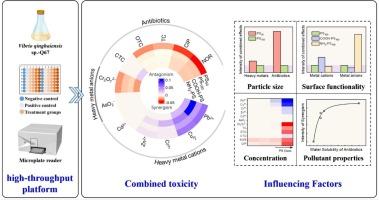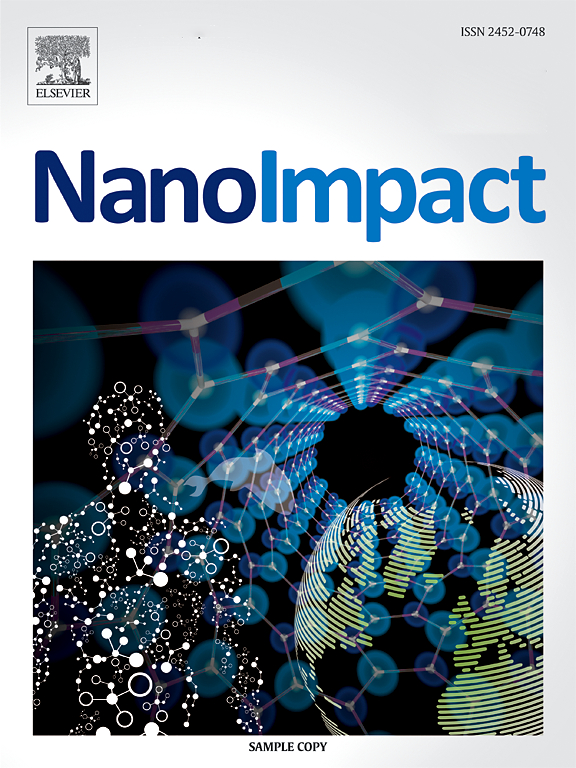利用发光细菌高通量筛选纳米塑料与共存污染物的联合毒性
IF 5.5
3区 环境科学与生态学
Q2 ENVIRONMENTAL SCIENCES
引用次数: 0
摘要
微/纳米塑料(MNPs)通常与水生环境中的重金属和抗生素等污染物共存,可能诱发复杂的联合毒性。然而,传统的mnp -污染物联合毒性评估方法通常受到效率低下、成本高和劳动密集型程序的挑战。本研究采用微孔板抑制发光菌(Vibrio qinghaiensis sp.-Q67),系统评价了4种不同尺寸和表面功能化的聚苯乙烯纳米塑料(PS-NPs)对7种重金属和5种抗生素的联合毒性。结果表明,金属阳离子(Cu2+、Zn2+、Pb2+、Cd2+和Cr3+)和氯四环素与PS-NPs联合主要诱导拮抗或加性毒性,阴离子(Cr2O72−和AsO2−)和抗生素(四环素、土霉素、诺氟沙星和环丙沙星)主要诱导增效或加性毒性。与100 nm的PS-NPs相比,较小的PS-NPs (50 nm)放大了毒性相互作用。羧基修饰的PS-NPs对阳离子表现出最明显的拮抗作用,而氨基修饰的PS-NPs与Cr2O72−的协同作用增强。在较高的PS-NP浓度和中等的共污染物浓度(即中位效应浓度的1/5或1倍)下,联合效应增强。水溶性越高的抗生素与PS-NPs的协同作用越明显,对金属阳离子的拮抗强度依次为Pb2+ >; Cu2+ > Cr3+ > Zn2+ > Cd2+。这种高通量策略有效地评估了复合毒性的多因素影响,为MNPs与污染物之间的毒性相互作用模式提供了系统的见解。本文章由计算机程序翻译,如有差异,请以英文原文为准。

High-throughput screening of combined toxicity of nanoplastics and scoexisting pollutants using luminescent bacterium
Micro/nanoplastics (MNPs) commonly coexist with contaminants such as heavy metals and antibiotics in aquatic environments, potentially inducing complex joint toxicity. However, conventional approaches for MNP-pollutant combined toxicity assessment are typically challenged by inefficiencies, high costs, and labor-intensive procedures. In this study, a high-throughput platform using microplate-based inhibition assays with a luminescent bacterium (Vibrio qinghaiensis sp.-Q67), was applied to systematically evaluate the combined toxicity of four polystyrene nanoplastics (PS-NPs), varying in size and surface functionalization, with seven heavy metals and five antibiotics. Results showed that metal cations (Cu2+, Zn2+, Pb2+, Cd2+, and Cr3+) and chlortetracycline combined with PS-NPs primarily induced antagonistic or additive toxicity, whereas anions ( and ) and antibiotics (tetracycline, oxytetracycline, norfloxacin, and ciprofloxacin) exhibited synergistic or additive toxicity. Smaller PS-NPs (50 nm) amplified the toxicity interactions compared to 100 nm PS-NPs. Carboxyl-modified PS-NPs exhibited the most pronounced antagonistic effects with cations, while amino-modified PS-NPs favored amplified synergistic effects with . The combined effects were intensified at higher PS-NP concentrations and at moderate co-contaminant concentrations (i.e., 1/5 or 1 × the median effect concentration). Antibiotics with higher water solubility exhibited more pronounced synergistic effects with PS-NPs, and the antagonism intensities for metal cations followed an order of Pb2+ > Cu2+ > Cr3+ > Zn2+ > Cd2+. This high-throughput strategy efficiently assessed multifactorial impacts on combined toxicity, providing systematic insights into the toxic interaction patterns between MNPs and pollutants.
求助全文
通过发布文献求助,成功后即可免费获取论文全文。
去求助
来源期刊

NanoImpact
Social Sciences-Safety Research
CiteScore
11.00
自引率
6.10%
发文量
69
审稿时长
23 days
期刊介绍:
NanoImpact is a multidisciplinary journal that focuses on nanosafety research and areas related to the impacts of manufactured nanomaterials on human and environmental systems and the behavior of nanomaterials in these systems.
 求助内容:
求助内容: 应助结果提醒方式:
应助结果提醒方式:


